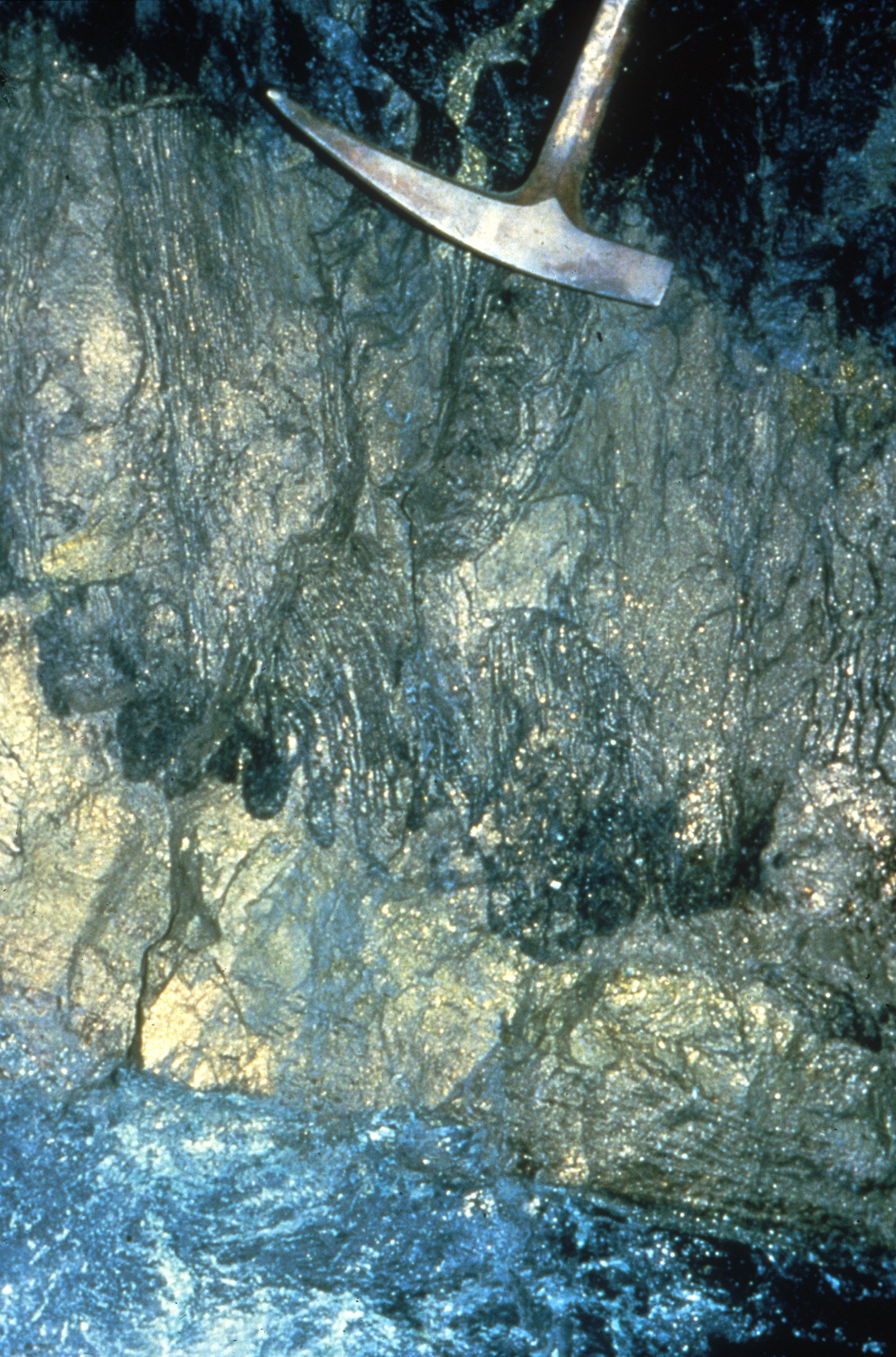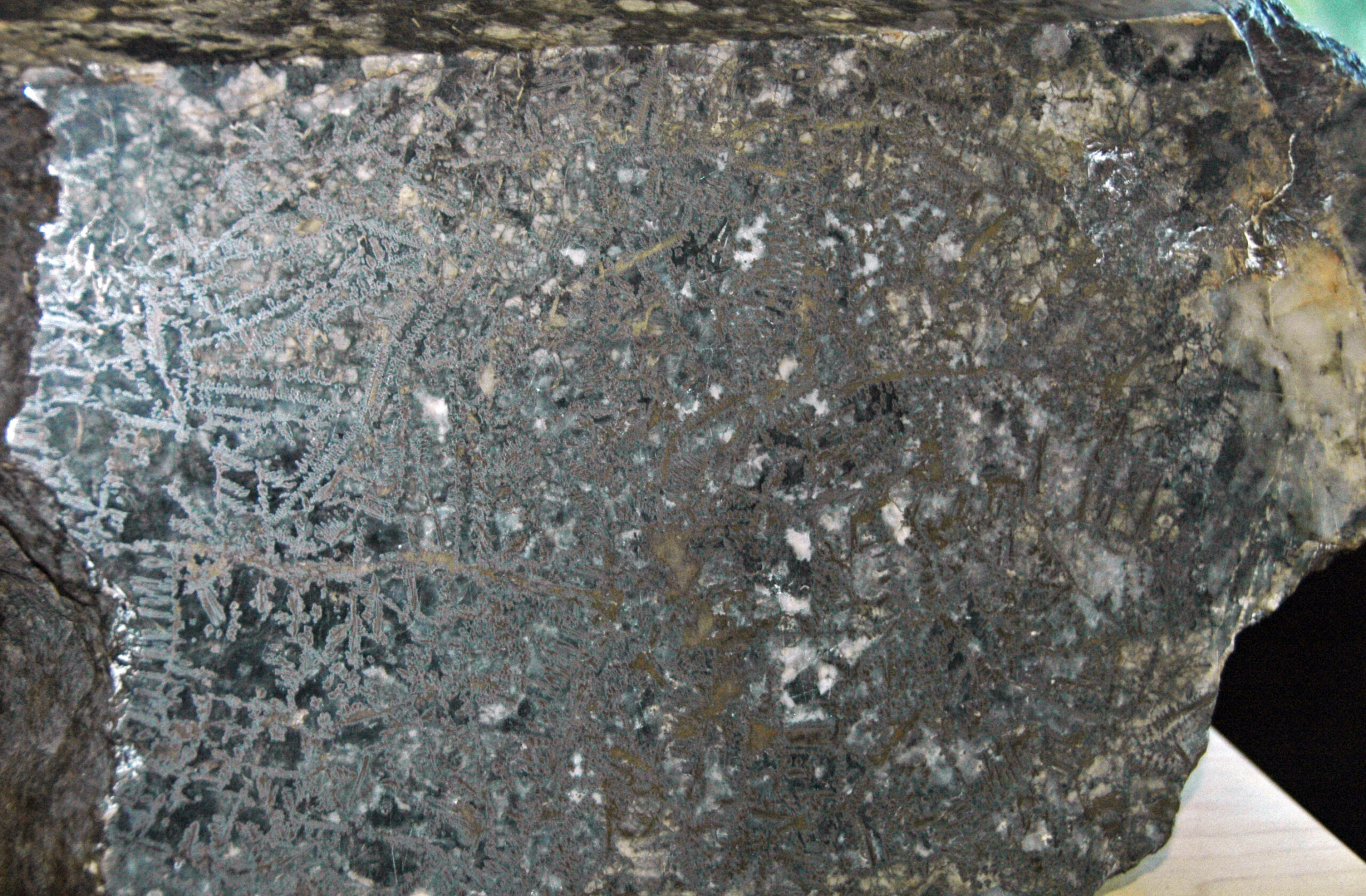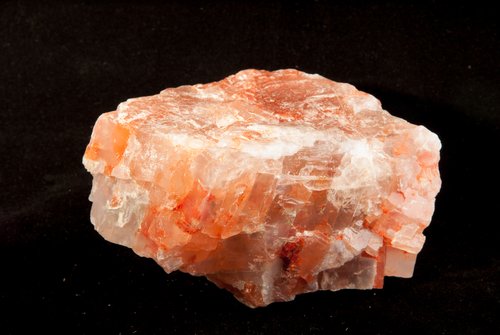The Ox Fault appears to have cut through the deposit and moved the eastern half elsewhere. On the eastern side of the fault a small arcuate mineralized zone is evident. Depending on whether the relative movement has been up, down or sideways this small zone may be just the “tip of an iceberg”.
[box type=”info” align=”aligncenter” ]Disclaimer: This is an editorial review of a public press release and not an endorsement. It may include opinions or points of view that may not be shared by the companies mentioned in the release. The editorial comments are highlighted so as to be easily separated from the release text and portions of the release not affecting this review may be deleted. Please view the full release here.[/box]
VANCOUVER, BRITISH COLUMBIA–(Marketwired – Sept. 23, 2013) – Gold Reach Resources Ltd. (TSX VENTURE:GRV) (Gold Reach and/or the Company) is pleased to announce that assay results for holes Ox13-106 to 110 from the Ox deposit have been received. The Ox deposit is located 4 kilometres north-northeast of the Company’s West Seel discovery, and both deposits occur on the Company’s 100% owned Ootsa Property located adjacent to the producing Huckleberry Mine south of Smithers, British Columbia.
[box type=”note” align=”aligncenter” ]We’ve provided a couple of location maps for the Ootsa property, which includes the Ox deposit.[/box]
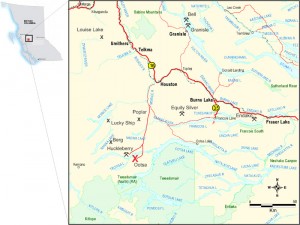

[box type=”note” align=”aligncenter” ]The Ox deposit is a crescent-shaped zone of disseminated and vein-controlled porphyry Cu mineralization. Deposits such as these are well sought after for their low to moderate grade high-tonnage ores.[/box]
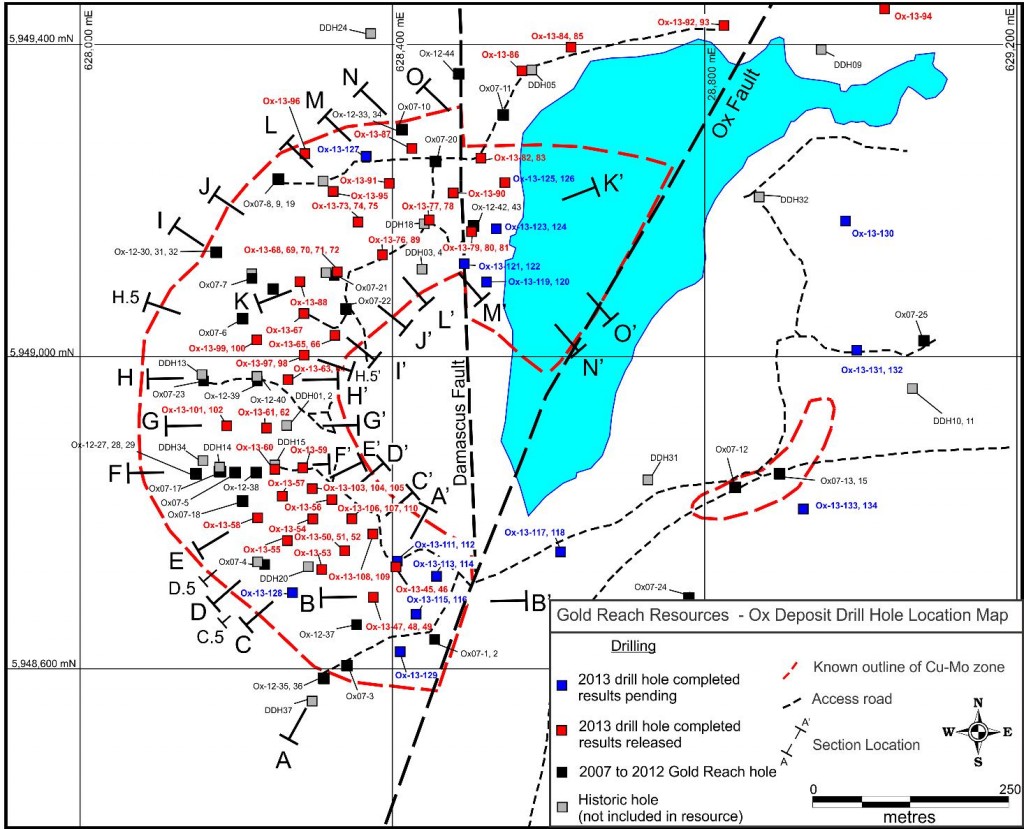
[box type=”note” align=”aligncenter” ]In the Ox deposit the main sulfide minerals include pyrite an iron sulfide, chalcopyrite a copper-iron sulfide and molybdenite a molybdenum sulfide. These are contained within heat affected rocks near the western margin of a granitoid porphyry body.
Typically, porphyry deposits consist of concentric shells of altered and mineralized rock on the flanks of a low grade or barren core. The Ox Fault appears to have cut through the deposit and moved the eastern half elsewhere. On the eastern side of the fault a small arcuate mineralized zone is evident. Depending on whether the relative movement has been up, down or sideways this small zone may be just the “tip of an iceberg”. Some movement along the Damascus Fault is evident as minor displacement of the northern segment of the deposit.
The big question for the project geologist should be: Where is the other half of the deposit? [/box]
HIGHLIGHTS
More High Grade Material EncounteredHole Ox13-107 intersected 64m of 0.65% copper equivalent including 24 metres of 0.72% copper equivalent.Hole Ox13-108 intersected 109.5m of 0.54% copper equivalent including 36 metres of 0.61% copper equivalent.Hole Ox13-110 intersected 103.3m of 0.66% copper equivalent including 40.6 metres of 0.79% copper equivalent.
[box type=”note” align=”aligncenter” ]”Copper equivalent” is calculated using baseline commodity prices and generally assumes a 100% recovery rate. Let’s ignore these “highlights” and decide for ourselves what the highlights are.[/box]
- Mineralization Starts Near Surface
- Mineralization in holes Ox13-106, 107, and 110 starts 4 metres vertically below surface.
- Mineralization in holes Ox13-108 and 109 starts 9 metres vertically below surface with the highest grades occurring closest to surface.
[box type=”note” align=”aligncenter” ]In the upper levels of copper ore deposits, a process called supergene enrichment creates higher grade ores as percolating rainwater interacts with the ore minerals. This is why the highest grades are occurring closest to the surface. The mineral makeup of these enriched zones tends to be different from the primary ore, so they will require different methods for extracting the ore minerals.[/box]
The 2013 drilling at the Ox deposit has focused on infilling and expanding near surface mineralization along a higher grade core that runs the length of the system, and is looking to increase resource categories, tonnage, and grade of the deposit. The drilling program is now focusing on infilling and expanding the large resource base at the Seel deposit.
[box type=”note” align=”aligncenter” ]Perhaps it would’ve been better to use the word “shell” rather than “core” in the above paragraph. The core of porphyry systems tend to be composed of low grade or barren material. Gold Reach is probably referring to one of the high grade ore shells which typically exist on the margins of porphyry systems. What has been extensively drilled is the western high grade shell. An eastern ore shell could exist but may have been moved elsewhere by movement along the Ox Fault. [/box]
Ox Drill Results
Holes Ox13-106, 107, and 110 were infill holes drilled within a gap between sections C-C’ and D-D’ and are shown on section C.5-C.5′. Holes Ox13-106 and 107 were short holes testing the western edge of mineralization. Hole Ox13-106 returned 30.6 metres grading 0.36% copper and 0.037% molybdenum (0.57% copper equivalent) from 6.5 to 37.1 metres depth, including 13.5 metres grading 0.46% copper and 0.034% molybdenum (0.67% copper equivalent) from 6.5 to 20 metres depth. Hole Ox13-107 returned 64 metres grading 0.37% copper and 0.052% molybdenum (0.65% copper equivalent) from 4 to 68 metres depth, including 24 metres grading 0.43% copper and 0.052% molybdenum (0.72% copper equivalent) from 42 to 66 metres depth. Hole Ox13-110 was drilled toward the southwest along the mineralized contact and intersected 103.3 metres grading 0.44% copper and 0.040% molybdenum (0.66% copper equivalent) from 5.4 to 108.7 metres depth, including 40.6 metres grading 0.57% copper and 0.034% molybdenum (0.79% copper equivalent) from 5.4 to 46 metres depth.
Holes Ox13-108 and 109 are shown on section C-C’ and were drilled toward the southwest to better define the southwest edge of mineralization on the section. Hole Ox13-108 returned 109.5 metres grading 0.33% copper and 0.038% molybdenum (0.54% copper equivalent) from 10.5 to 120 metres depth, including 36 metres grading 0.46% copper and 0.022% molybdenum (0.61% copper equivalent) from 42 to 78 metres depth. Hole Ox13-109 returned 69.8 metres grading 0.30% copper and 0.020% molybdenum (0.42% copper equivalent) from 11.7 to 81.5 metres depth, including 10.3 metres grading 0.50% copper and 0.024% molybdenum (0.66% copper equivalent) from 11.7 to 22 metres depth.
Summary of select drill intercepts – Holes Ox13-106 to 110
[box type=”note” align=”aligncenter” ]What really sticks in the drill results are the consistency of the copper grades and the potentially wide zones. However, don’t get too excited as Gold Reach hasn’t estimated the true widths (thicknesses) of the mineralized intervals yet. In addition, their copper equivalent calculations are strongly dependent on market prices and assume 100% recovery rates.[/box]
| Drill Hole | From (m) | To (m) | Width (m)* | Cu % | Mo % | Au g/t | Ag g/t | Cu Eq. %** |
| Ox13-106 | 6.5 | 37.1 | 30.6 | 0.36 | 0.037 | 0.07 | 1.43 | 0.57 |
| including | 6.5 | 20.0 | 13.5 | 0.46 | 0.034 | 0.09 | 1.72 | 0.67 |
| Ox13-107 | 4.0 | 68.0 | 64.0 | 0.37 | 0.052 | 0.08 | 1.57 | 0.65 |
| including | 42.0 | 66.0 | 24.0 | 0.43 | 0.052 | 0.09 | 2.04 | 0.72 |
| Ox13-108 | 10.5 | 120.0 | 109.5 | 0.33 | 0.038 | 0.06 | 1.57 | 0.54 |
| including | 42.0 | 78.0 | 36.0 | 0.46 | 0.022 | 0.07 | 1.92 | 0.61 |
| including | 102.0 | 120.0 | 18.0 | 0.42 | 0.045 | 0.07 | 2.10 | 0.67 |
| Ox13-108 | 161.8 | 172.0 | 10.2 | 0.22 | 0.017 | 0.05 | 1.54 | 0.34 |
| Ox13-109 | 11.7 | 81.5 | 69.8 | 0.30 | 0.020 | 0.04 | 1.17 | 0.42 |
| including | 11.7 | 22.0 | 10.3 | 0.50 | 0.024 | 0.07 | 1.83 | 0.66 |
| Ox13-109 | 102.0 | 168.0 | 66.0 | 0.20 | 0.016 | 0.03 | 1.14 | 0.30 |
| Ox13-110 | 5.4 | 108.7 | 103.3 | 0.44 | 0.040 | 0.06 | 1.89 | 0.66 |
| including | 5.4 | 46.0 | 40.6 | 0.57 | 0.034 | 0.09 | 2.62 | 0.79 |
| Ox13-110 | 116.8 | 205.6 | 88.8 | 0.24 | 0.022 | 0.04 | 2.10 | 0.37 |
*Width refers to drill hole intercepts, true widths have not been determined.
**Cu Eq. (copper equivalent) has been used to express the combined value of copper, molybdenum, gold and silver as a percentage of copper, and is provided for illustrative purposes only. No allowances have been made for recovery losses that may occur should mining eventually result. Calculations use metal prices of US $2.50/lb copper, $1200/oz gold, $15 silver, and $10/lb molybdenum using the formula Cu Eq.% = Cu% + (Au g/t x 0.701) + (Ag g/t x 0.0087) + (Mo% x 4.01).
[box type=”note” align=”aligncenter” ]Grades above 1% copper with high tonnage are normally the target for ensuring profitable copper mines. One good thing though is that the copper grades at Ox are still quite reasonable and consistent. If the ore minerals can be separated and concentrated economically, then they may be able to make money from this deposit. I don’t believe the Ox deposit can be marketed on the basis of its contained molybdenum alone. There are many more deposits of molybdenum around the world which surpass this one. For example, the Merlin deposit in northern Australia is the highest grade molybdenum deposit in the world. It has 13 million tonnes @ 0.8% molybdenum, 14 g/t rhenium, 0.2% copper and 4.8 g/t silver, and it hasn’t even been mined yet due to the current low molybdenum price. Realistically, the gold, silver and molybdenum grades within the Ox deposit are quite low and are merely used as credits to make the copper equivalent figure higher. Besides, these extra commodities may not be easily extracted and may be lost, so when it comes to the crunch they may not have any value at all.[/box]
Dr. Shane Ebert, president of Gold Reach, commented: “Infill and step out drilling at Ox continues to intersect strong grades within a continuous near surface zone of mineralization. The Company is extremely pleased with the advances made at the Ox deposit this year and we look forward to further advancing the deposit through metallurgical test work and a pit constrained resource update expected later in the year.”
Drilling Update
Assay results for the first 66 holes drilled at Ox during the 2013 program have been received (holes Ox13-45 to Ox13-110). An additional 23 holes have been completed at Ox (Ox13-111 to 134) and are in the lab getting assayed. Five holes have been completed at East Seel (S13-147, 148, 149, 151, 152) and one hole has been completed at West Seel (S13-150). One drill is currently working on hole S13-154 at East Seel and the second drill is working on hole S13-153 at West Seel.
The current round of drilling is focusing on infilling and expanding three areas of higher grade near-surface mineralization with open pit potential at Ox, East Seel, and West Seel. Previous drilling in all three zones has intersected significant grades at shallow depths including hole S11-90 at East Seel which returned 194 metres grading 0.37% copper and 0.42 g/t gold (0.66% copper equivalent) starting at 22 metres depth (previously released), hole S06-42 just north of East Seel which returned 138 metres grading 0.85% Cu and 23 g/t Ag (1% copper equivalent) starting at 22 metres depth (previously released), and hole S12-108 at West Seel which intersected 316 metres grading 0.56% copper equivalent starting at 24 metres down hole, including 30 metres grading 1% copper equivalent starting at 74 metres down hole.
Additional information is available on our website at www.goldreachresources.com.
About Gold Reach Resources
Gold Reach Resources Ltd. has made an important new and strategic Copper Gold Molybdenum discovery on its 100% held Ootsa Property located adjacent to the 16,000 tonne per day Huckleberry Mine currently producing Cu Au and Mo in central BC.
Gold Reach’s Ootsa property is an advanced stage exploration project containing the Seel and Ox porphyry systems both with compliant resource estimates open for expansion. The Company has recently added the discovery of the West Seel Porphyry where drill hole S12-118 encountered 128 metres grading 1.01% Cu Eq. consisting of 0.43% Cu, 0.33 g/t Au, 0.076% Mo and 4.76 g/t Ag within a much larger interval of 537 metres grading 0.65% Cu Eq. consisting of 0.27% Cu, 0.19 g/t Au, 0.055% Mo, and 2.69 g/t Ag. The Seel deposit contains 67.8 million tonnes of indicated resources and 410.9 million tonnes of inferred resources at a 0.2% copper equivalent cut off. The Ox deposit contains 52.65 million tonnes of inferred resources at a 0.2% copper equivalent cut off.
[box type=”note” align=”aligncenter” ]Below the “cut off” grade it no longer becomes economically viable to mine the ore. Let’s put the Ox and Seel deposits into perspective with a world class copper deposit, for example Carapateena in South Australia. This IOCG deposit has 203 million tonnes of ore grading at 1.31% copper, 0.56g/t gold and is still only partially explored. The best drilling results to date from Carapateena include 905 metre at 2.1% copper and 1.0 g/t gold. Just remember grade is king![/box]
Quality Control
All drill core is logged, photographed, and cut in half with a diamond saw. Half of the core is bagged and sent to AGAT Laboratories for analysis (which is an ISO 9001 and ISO/IEC 17025 certified lab), while the other half is archived and stored on site for verification and reference purposes. Gold is assayed by standard fire assay methods with 45 additional elements analyzed by Induced Coupled Plasma (ICP) utilizing a 4-acid digestion. Duplicate samples, blanks, and certified standards are included with every sample batch and then checked to ensure proper quality assurance and quality control.
[box type=”note” align=”aligncenter” ]This is pretty much a stock standard QA/QC statement seen in most company press releases. A link to a downloadable document file with more information on their QA/QC program would be useful here.[/box]
Dr. Shane Ebert, P.Geo., President of the Company, is the Qualified Person for the Ootsa project as defined by National Instrument 43-101 and has approved the technical disclosure contained in this news release.
[box type=”success” align=”aligncenter” ]Have a company or release you’d like us to look at? Let us know though our contact page, through Google+, Twitter or Facebook.[/box]

